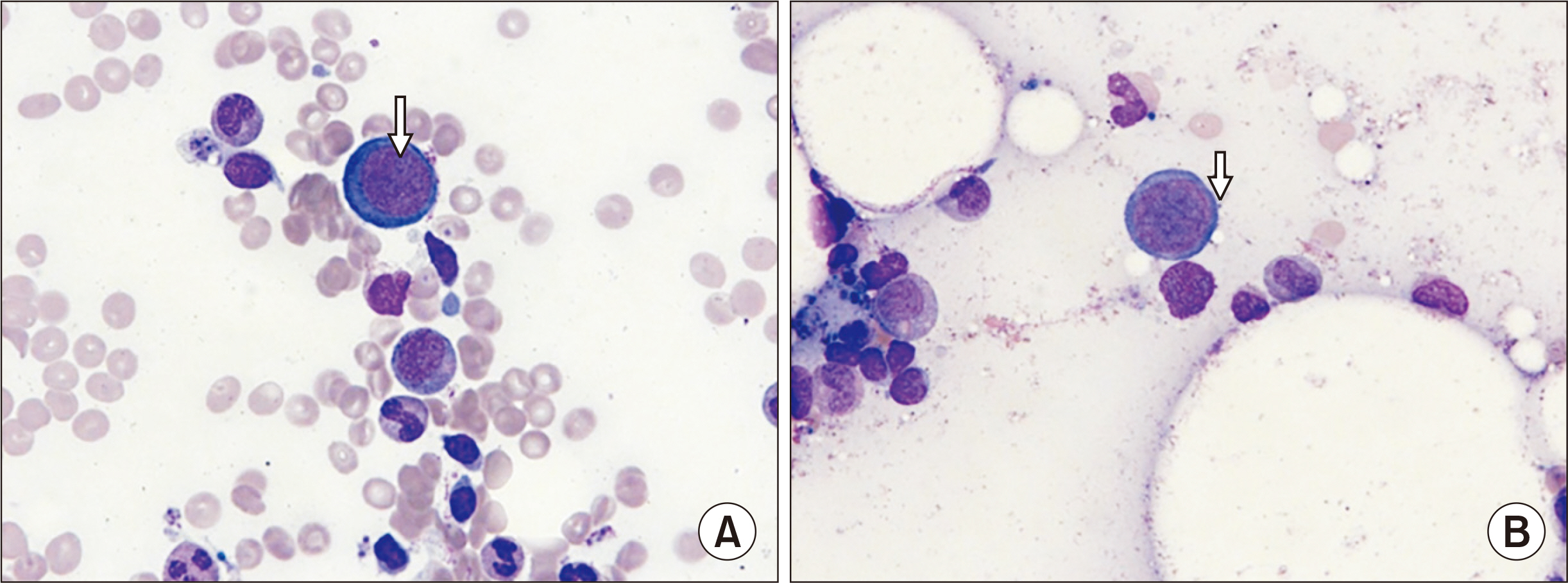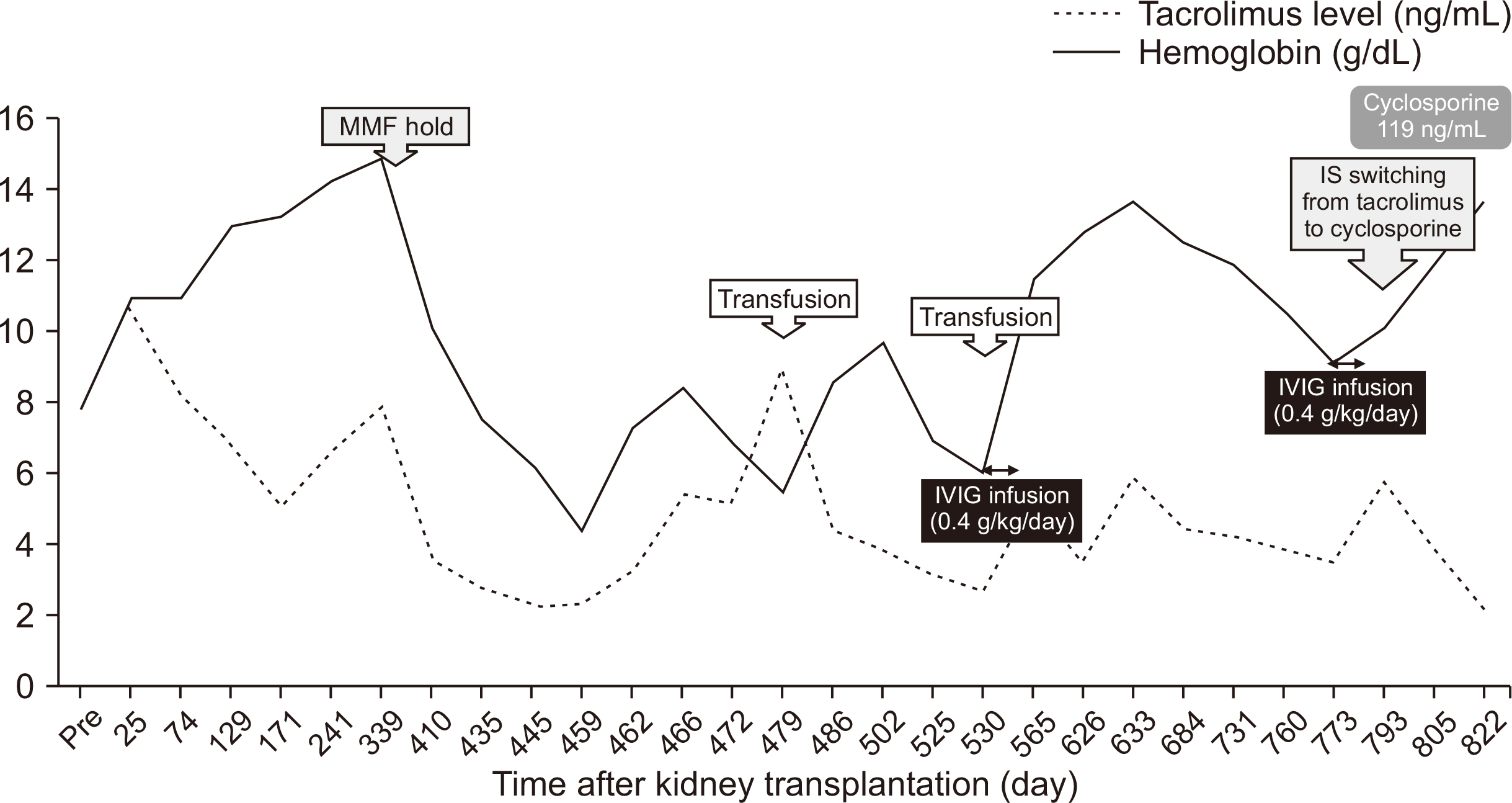Korean J Transplant.
2020 Sep;34(3):199-203. 10.4285/kjt.2020.34.3.199.
Recurrent parvovirus B19 infection-associated pure red cell aplasia in a kidney transplant patient
- Affiliations
-
- 1Department of Surgery, Seoul National University Hospital, Seoul, Korea
- 2Department of Laboratory Medicine, Seoul National University Hospital, Seoul, Korea
- 3Transplantation Research Institute, Seoul National University College of Medicine, Seoul, Korea
- 4Department of Internal Medicine, Seoul National University Hospital, Seoul, Korea
- 5Transplantation Center, Seoul National University Hospital, Seoul, Korea
- KMID: 2507165
- DOI: http://doi.org/10.4285/kjt.2020.34.3.199
Abstract
- Posttransplant anemia is a common complication after kidney transplantation. Parvovirus B19 (PVB19) infection can induce pure red cell aplasia (PRCA) in immunosuppressed transplant patients. We herein report a case of recurrent PVB19-associated PRCA in a kidney transplant patient. A 49-year-old woman presented with anemia and normal renal function 1 year after a deceased-donor kidney transplantation for immunoglobulin A nephropathy-related end-stage renal disease. She received desensitization therapy, and 2 years later, she underwent transplantation with thymoglobulin induction. Despite repeated red cell transfusion and erythropoietin therapy, her anemia aggravated progressively. Bone marrow biopsy revealed normocytic normochromic PRCA. Real-time polymerase chain reaction detected a high plasma load of PVB19. Administration of intravenous immunoglobulin (IVIG) at 2 g/kg with adjuvant reduction of tacrolimus and discontinuation of myfortic acid effectively treated the anemia. However, the PVB19 load remained high, and PRCA recurred 7 months after the initial IVIG treatment. Tacrolimus was switched to cyclosporine in the second IVIG treatment, which successfully improved PRCA and reduced the PVB19 load. Our case suggested that PVB19-associated PRCA should be suspected when persistent anemia is observed in kidney transplant patients with heavy immunosuppression and that PVB19-associated PRCA can recur in the presence of persistent PVB19 viremia.
Keyword
Figure
Reference
-
1. Vanrenterghem Y. 2004; Anaemia after renal transplantation. Nephrol Dial Transplant. 19 Suppl 5:V54–8. DOI: 10.1093/ndt/gfh1057. PMID: 15284361. PMCID: PMC7479824.
Article2. Yorgin PD, Scandling JD, Belson A, Sanchez J, Alexander SR, Andreoni KA. 2002; Late post-transplant anemia in adult renal transplant recipients: an under-recognized problem? Am J Transplant. 2:429–35. DOI: 10.1034/j.1600-6143.2002.20506.x. PMID: 12123208.
Article3. Pabisiak K, Stępniewska J, Ciechanowski K. 2019; Pure red cell aplasia after kidney transplantation: parvovirus B19 culprit or coincidence? Ann Transplant. 24:123–31. DOI: 10.12659/AOT.913663. PMID: 30833537. PMCID: PMC6419532.
Article4. Choi SH, Chang SP, Won JC, Lee JS, Chi HS, Yang WS, et al. 2002; A case of persistent anemia in a renal transplant recipient: association with parvovirus B19 infection. Scand J Infect Dis. 34:71–5. DOI: 10.1080/003655402753395247. PMID: 11874173.
Article5. Ki CS, Kim IS, Kim JW, Lee NY, Kim SH, Lee KW, et al. 2005; Incidence and clinical significance of human parvovirus B19 infection in kidney transplant recipients. Clin Transplant. 19:751–5. DOI: 10.1111/j.1399-0012.2005.00415.x. PMID: 16313320.
Article6. Geetha D, Zachary JB, Baldado HM, Kronz JD, Kraus ES. 2000; Pure red cell aplasia caused by Parvovirus B19 infection in solid organ transplant recipients: a case report and review of literature. Clin Transplant. 14:586–91. DOI: 10.1034/j.1399-0012.2000.140612.x. PMID: 11127313. PMCID: PMC4146984.
Article7. Rao KR, Patel AR, Anderson MJ, Hodgson J, Jones SE, Pattison JR. 1983; Infection with parvovirus-like virus and aplastic crisis in chronic hemolytic anemia. Ann Intern Med. 98:930–2. DOI: 10.7326/0003-4819-98-6-930. PMID: 6859707.
Article8. Ager EA, Chin TD, Poland JD. 1966; Epidemic erythema infectiosum. N Engl J Med. 275:1326–31. DOI: 10.1056/NEJM196612152752402. PMID: 5923532.
Article9. Crabol Y, Terrier B, Rozenberg F, Pestre V, Legendre C, Hermine O, et al. 2013; Intravenous immunoglobulin therapy for pure red cell aplasia related to human parvovirus b19 infection: a retrospective study of 10 patients and review of the literature. Clin Infect Dis. 56:968–77. DOI: 10.1093/cid/cis1046. PMID: 23243178.
Article10. Eid AJ, Brown RA, Patel R, Razonable RR. 2006; Parvovirus B19 infection after transplantation: a review of 98 cases. Clin Infect Dis. 43:40–8. DOI: 10.1086/504812. PMID: 16758416.
Article11. Bonvicini F, Bua G, Manaresi E, Gallinella G. 2015; Antiviral effect of cidofovir on parvovirus B19 replication. Antiviral Res. 113:11–8. DOI: 10.1016/j.antiviral.2014.11.004. PMID: 25446336.
Article12. Baek CH, Kim H, Yang WS, Han DJ, Park SK. 2017; Risk factors and long-term outcomes of parvovirus B19 infection in kidney transplant patients. Transpl Infect Dis. 19:e12754. DOI: 10.1111/tid.12754. PMID: 28741797.
Article13. Kaya B, Paydas S. 2019; Recurrence of pure red cell aplasia in a kidney transplant recipient due to reactivation of parvovirus B19 infection despite two cycles of intravenous immunoglobulin therapy. Exp Clin Transplant. 17(Suppl 1):195–7. DOI: 10.6002/ect.MESOT2018.P63. PMID: 30777553.
Article14. Pinto V, Grandy J, Zambrano P, Corta B, Salas P, Salgado I, et al. 2008; Severe anemia from parvovirus b19 infection in pediatric renal transplant recipients: two case reports. Transplant Proc. 40:3261–4. DOI: 10.1016/j.transproceed.2008.03.127. PMID: 19010248.
Article15. Eid AJ, Chen SF. AST Infectious Diseases Community of Practice. 2013; Human parvovirus B19 in solid organ transplantation. Am J Transplant. 13 Suppl 4:201–5. DOI: 10.1111/ajt.12111. PMID: 23465012.
Article
- Full Text Links
- Actions
-
Cited
- CITED
-
- Close
- Share
- Similar articles
-
- Parvovirus B19-induced Pure Red Cell Aplasia in a Liver Transplant Recipient
- Spontaneous Subcapsular Hematoma on a Transplanted Kidney
- A Case of Pure Red Cell Aplasia Due to Parvovirus B19 Infection in a Renal Transplant Recipient
- A Case of Immunoglobulin Therapy for Pure Red Cell Aplasia Induced by Parvovirus B19
- Pure Red Cell Aplasia Due to Parvovirus B19 in Renal Transplants



